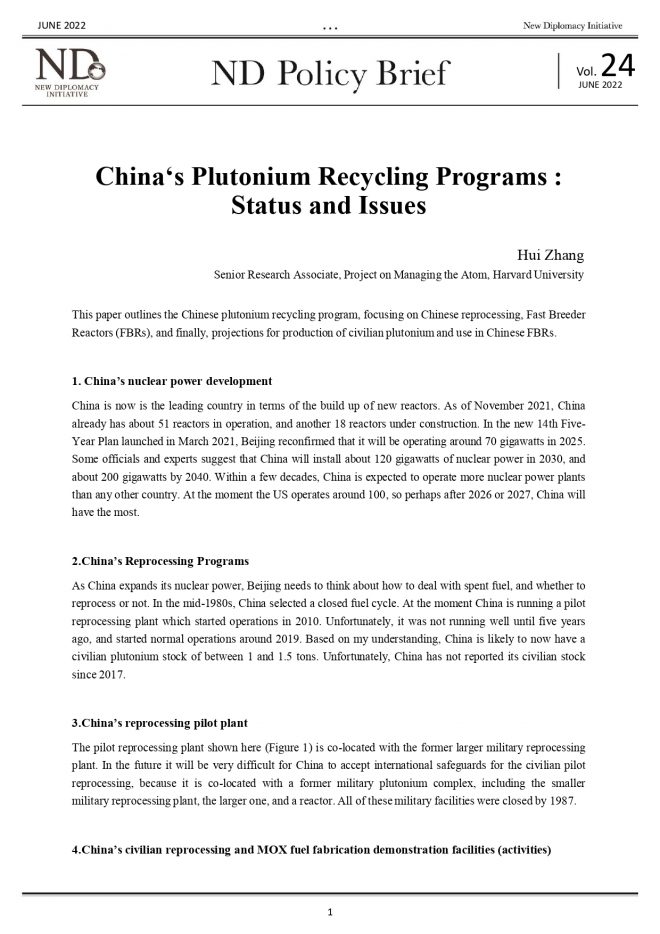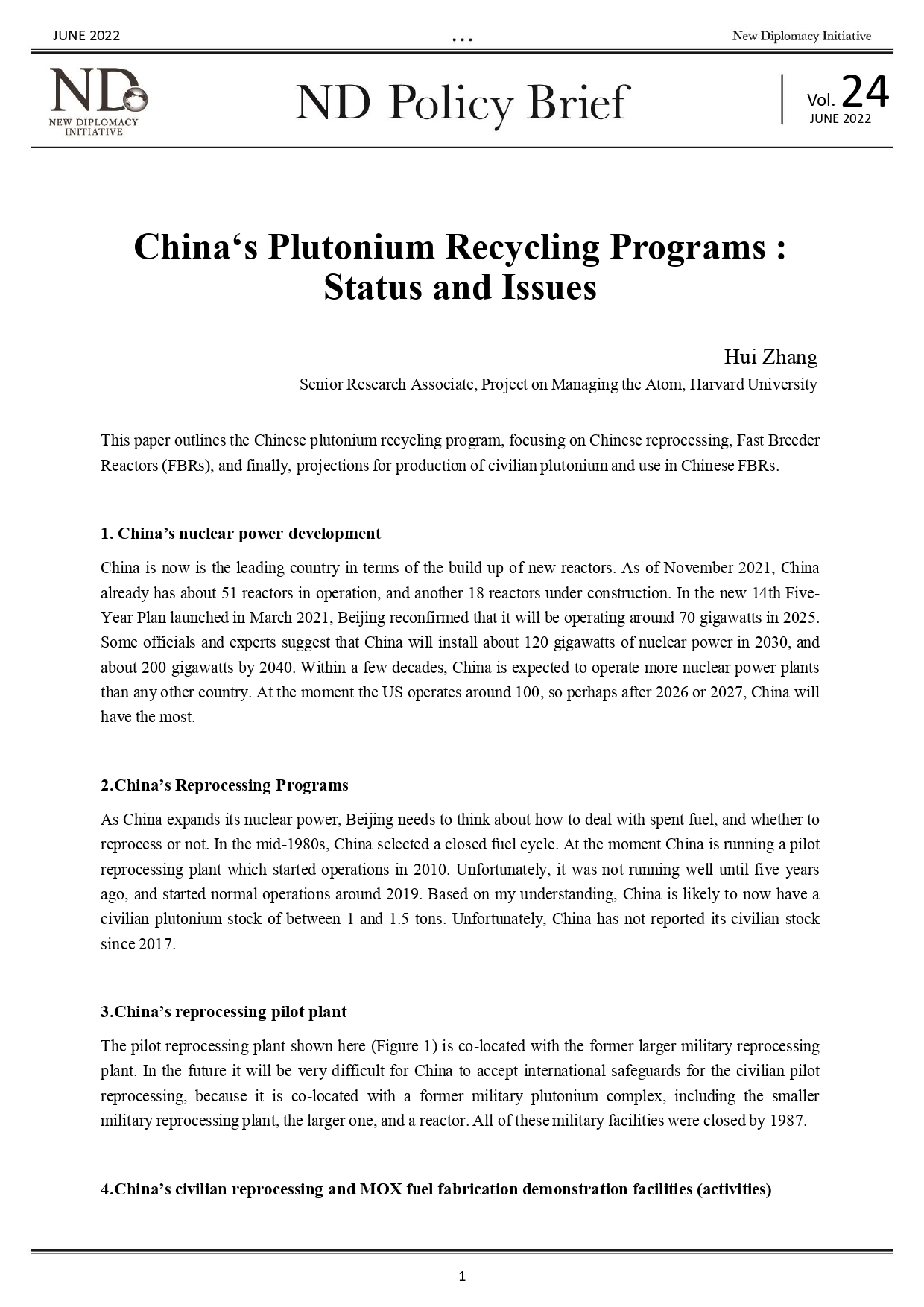Hui Zhang
Senior Research Associate, Project on Managing the Atom, Harvard University
This paper outlines the Chinese plutonium recycling program, focusing on Chinese reprocessing, Fast Breeder Reactors (FBRs), and finally, projections for production of civilian plutonium and use in Chinese FBRs.
1. China’s nuclear power development
China is now is the leading country in terms of the build up of new reactors. As of November 2021, China already has about 51 reactors in operation, and another 18 reactors under construction. In the new 14th Five-Year Plan launched in March 2021, Beijing reconfirmed that it will be operating around 70 gigawatts in 2025. Some officials and experts suggest that China will install about 120 gigawatts of nuclear power in 2030, and about 200 gigawatts by 2040. Within a few decades, China is expected to operate more nuclear power plants than any other country. At the moment the US operates around 100, so perhaps after 2026 or 2027, China will have the most.
2.China’s Reprocessing Programs
As China expands its nuclear power, Beijing needs to think about how to deal with spent fuel, and whether to reprocess or not. In the mid-1980s, China selected a closed fuel cycle. At the moment China is running a pilot reprocessing plant which started operations in 2010. Unfortunately, it was not running well until five years ago, and started normal operations around 2019. Based on my understanding, China is likely to now have a civilian plutonium stock of between 1 and 1.5 tons. Unfortunately, China has not reported its civilian stock since 2017.
3.China’s reprocessing pilot plant
The pilot reprocessing plant shown here (Figure 1, see PDF) is co-located with the former larger military reprocessing plant. In the future it will be very difficult for China to accept international safeguards for the civilian pilot reprocessing, because it is co-located with a former military plutonium complex, including the smaller military reprocessing plant, the larger one, and a reactor. All of these military facilities were closed by 1987.
4.China’s civilian reprocessing and MOX fuel fabrication demonstration facilities (activities)
Based on reporting to IAEA under the voluntary Guidelines for the Management of Plutonium (contained in INFCIRC/549), Table 1 shows China’s report on cumulative amount of plutonium, the last in 2016, with a total of 40.9 kilograms. Since then there is no reporting, which is one concern of international experts about Chinese civilian plutonium. In this table, I assume a cumulative separation of 500 kilograms in 2019, based on various sources.
Meanwhile, China since 2015 started another two demonstration reprocessing plants at Jinta. The government mentioned the construction of the first reprocessing plant of 200 tons, but no one knew where it was and there was no public disclosure of the location, it was kept very secret.
I recently identified these two reprocessing facilities, based on open source information and satellite imagery. This is in a very remote area in the desert, close to Jiuquan, not far from the pilot reprocessing plant. Based on analysis of the satellite imagery (Figure 2, Figure 3), you can see the first reprocessing plant under very active construction. There is also another MOX facility close to the reprocessing plant, with a capacity of about 20t/year.
Early this year (2021) in March, based on many Chinese websites, I found evidence of purchase of equipment for the second reprocessing plant. This was very surprising, as I was working on the first plant, when I found many documents about purchase for the second reprocessing plant. Based on documents from the purchase website, I assume that the first plant was finished the civil engineering stage by February 2020, and then entered the equipment installation stage. I assume the construction of the second one started around the end of 2020. The MOX is being built at the same site. This information is based on my estimates, because the government and the China National Nuclear Corporation (CNNC) do not talk about it. It appears that both of the reprocessing plants will be running on time, with the first supposed to be running by 2025 and the second by 2030.
Meanwhile, China is negotiating with France since 2007 to buy a larger reprocessing plant with a capacity of 800 tons per year. This has entered commercial negotiations since 2015, but unfortunately because of local protests in Lianyungang, Jiangsu in 2016, this program is pending. Thus at the moment, no new site has been selected. The CNNC planned to start construction around 2020. Unfortunately, there are not yet any updates about the site issue. They are assuming to start operations in around 2030, but I believe that there will still be no hope by 2035.
5. The cost of reprocessing
At Harvard, with colleagues Mathew Bunn and Li Kang, we made an estimate of the cost of reprocessing. Our conclusion is that for China a reprocessing program would be much more expensive than dry cask storage1.
We estimated the final per-kilogram reprocessing cost to be about $2,000 per kilogram (Table 2, Table 3), which is very expensive. We also made an estimate about LEU direct disposal versus recycling as MOX, which may be similar for Japan. Our conclusion is that even under the same favorable assumptions for reprocessing, such as a very low estimated cost for the plant, reprocessing would increase the fuel cycle cost by about two thirds. Meanwhile, also compared with breeders, direct disposal is much cheaper.
6. China’s Experimental Fast Reactor (CEFR)
Since 2010 China is also running the Chinese Experimental Fast Reactor (CEFR). Once again, since its operations have had a lot of problems, it has a very low capacity. The data from 2011-2018 (slide page 15) shows that the capacity factor is very low, just about 1%, meaning that even for a pilot fast reactor, its performance is very bad. But even so, China still has pursued a larger reactor case. So, based on this, we know that China at the moment has been building two demonstration FBRs (CFR-600). The first is 600 Megawatts. Construction started in 2017, and by January 2020 the civil engineering had already been finished, and it had entered the equipment installation stage. This unit is scheduled to start operation in 2023. Once again, no one was talking about the second one in the Chinese media. While I was working on the first, checking satellite imagery and documents about the construction, last March [in 2020] I surprisingly found the second one with excavation going on, after finding bidding and purchase documents on websites. In an interview with an industry magazine last May, I predicted that the construction would start within seven months. Indeed the construction of the second reactor started last December (China National Nuclear Corporation (CNNC) made the announcement). I assume the second will be in operation by 2026.
The second has the same design as the first, and they also share some facilities (Figure 4). Construction has already begun in December last year (2020), as I just said, and I assume it will start operations around 2026.
For both, in particular for the first one based on a contract between China and Russia, for the first seven years and the first initial load, it is supposed to be using HEU, and later could be Chinese MOX. Meanwhile, China is working on a larger commercial CFR-1000. They were supposed to make the final decision in 2020 whether to go ahead with this larger one, but one year later, it seems, the final decision has not yet been made, meaning that it may be delayed. Based on the early plans, it is assuming to start construction by 2028 and operations in 2034.
7. Future projections and scenarios
Based on the Chinese current status of plans, I estimated the separated plutonium China could have in the coming decades if it follows the current schedule, for several scenarios (Table 4). For the high scenario case based on the current Chinese programs, it would be about 20 tons and over 100 tons of separated plutonium by 2030 and 2040 respectively, a large number. Even for the very low case, meaning without the 800 ton per year reprocessing plant and with the other under construction reprocessing plants at half capacity, it would still be over 30 tons by 2040 and 10 tons by 2030. This is still much larger than the current Chinese military plutonium stockpile, which is just 3 tons. 3 tons is around 1000 warheads..
Also, the assumption about how much to be used in FBRs differs for different scenarios (Table 5). Here again, we find that even for the very low case of plutonium separation, that is, without the larger 800 ton per year reprocessing plant and with all the other pilot plants running at half capacity, this is still big enough for the very high case of plutonium use for FBR, based on the estimates.
The graph on Figure 5, you can see the green line showing the low case of the supply of plutonium, and the black dashed line, the high case of the use of plutonium. Even the green line is much higher than needed for the FBRs. That suggests that China actually has no need for the 800 ton per year reprocessing plant in the near future, at least until 2040. I therefore conclude that if a 800t/y reprocessing plant was started China would have a huge stock of reactor-grade plutonium, like Japan and France do.
8. Some suggestions
Our study shows that the Chinese reprocessing and plutonium recycling is much more costly than once-through use of the LWR. Therefore China should postpone the large reprocessing plant, and take an interim storage approach which offers a safe, flexible and cost-effective near term approach to spent fuel management. Tatsujiro Suzuki ,Allison Macfarlane and other colleagues have a very excellent report on interim storage issues2.
I also suggest that in order to reduce international concerns about its civilian plutonium, China should make its plutonium recycling programs more transparent, including timely reporting of its civilian plutonium stockpile as it did before 2017. China has not recently reported this, which is a big concern for the international community. Some experts also have concern about China maybe using the FBRs to produce weapons-grade plutonium in the “blanket.” Based on my estimate, each CFR600 can produce around 200 kilograms of weapon-grade plutonium per year. This is also a large number compared with its smaller military plutonium, and is another reason China needs to be more transparent regarding its plutonium program.
Note:
1.Bunn, Zhang, and Li, “The Cost of Reprocessing in China”
2.Bunn, Matthew, John P. Holdren, Allison Macfarlane, Susan E. Pickett, Atsuyuki Suzuki, Tatsujiro Suzuki and Jennifer Weeks. “Interim Storage of Spent Nuclear Fuel: A Safe, Flexible, and Cost-Effective Near-Term Approach to Spent Fuel Management.” Managing the Atom Project, Belfer Center and Project on Sociotechnics of Nuclear Energy, University of Tokyo.
※This paper is based on the author’s presentation at the international symposium “Growing Plutonium Stockpiles and the Rokkasho Reprocessing Plant: Reality of Nuclear Fuel Cycle and Security in East Asia” , Dec. 18-19, 2021. The views expressed here are those of the author.
※This project is supported by a grant from “act beyond trust” (abt) .




